-
本文考虑如下控制系统
其中:
$ \boldsymbol{X}\left( t \right)\in {{\mathbb{R}}^{n}} $ 表示流体的温度、湿度、密度等物理参数,矩阵A,$ \boldsymbol{B}\in {{\mathbb{R}}^{n\times n}} $ 且(A,B)能稳,$ \boldsymbol{U}\left( x, t \right)\in {{\mathbb{R}}^{n}} $ 为状态变量,矩阵$ {\mathit{\pmb{\Lambda}}} \in {{\mathbb{R}}^{n\times n}}, \boldsymbol{C}\left( t \right)\in {{\mathbb{R}}^{n}} $ 是控制输入,0表示零矩阵或零向量.
HTML
-
本文引入一个变换
$ \left( \boldsymbol{X}, \boldsymbol{U} \right)\mapsto \left( \boldsymbol{X}, \boldsymbol{W} \right) $ :这里的核函数
$ {\mathit{\pmb{\Phi}}} \left( x, y \right)\in {{\mathbb{R}}^{n\times n}} $ 和矩阵函数$ {\mathit{\pmb{\Psi}}} \left( x \right)\in {{\mathbb{R}}^{n\times n}} $ 待定. 该变换将系统(1)转换为一个指数稳定的目标系统,从而设计出控制律,那么闭环系统的稳定性就可以通过该变换及其逆变换建立起来. 选定的目标系统如下其中选定
$ \boldsymbol{K}\in {{\mathbb{R}}^{n\times n}} $ 使得A+BK是Hurwitz矩阵,为了满足方程组(3)第4式,取控制律为取核函数Φ(x,y)和矩阵函数Ψ(x)满足如下方程组
通过方程组(2)第2式以及方程组(3)第3式,可以得到矩阵函数Ψ(x)的一个边界条件为
此外,状态X(t)满足方程组(1)第1式和方程组(3)第1式,
可取如下条件成立
首先,根据矩阵函数方程组(5)第4式及其边界条件(6)和(8),本文得到矩阵方程的一个级数解为
其次由方程组(5)及式(9),可将核函数满足的边界条件转化为
可将核函数化为积分方程,再利用逐次逼近法求得近似解,其求解过程可参考文献[15]. 最后得到核函数解为
-
首先证明目标系统(3)的稳定性.
引理1 对于目标系统(3),存在α>0,β>0,使得
即目标系统在H1范数意义下指数稳定,其中‖·‖表示欧几里得范数,‖W(t)‖H1表示W(t)的H1范数,即
证 选取李雅普诺夫函数
这里的矩阵P>0是Lyapunov函数
的解,其中I表示n阶单位阵,a>0是需要被确定的参数. 对Lyapunov函数(13)两边关于t求导,由于W满足方程组(3),所以有
通过分部积分,由边界条件方程组(3)第3式和第(4)式,有
因为W满足方程组(3)第1式,所以V(t)满足
由Agmon不等式、Cauchy-Schwartz不等式和Young不等式
取
再由Poincare不等式及
得
又因为
其中λmax(P)是P的最大特征值,那么,由(13)式可得
其中
就可以得到
这里
$ \beta =\frac{1}{2{{\alpha }_{2}}} $ . 由式(17)和式(18)得到式(12)成立,从而就证明了闭环系统是稳定的.证明变换(2)可逆,需找到它的逆变换,故假设逆变换具有如下形式
按照求解核函数Φ(x,y),Ψ(x)的思路和方法,能得到
引理2 变换(2)及其逆变换(19)均为有界算子,即存在正整数δ,δ,γ和γ使得
证 从变换(2)第2式及范数的性质,可得
接下来需要对第2项和第3项进行估计. 首先
根据Holder不等式
其中
同理由逆变换可得
其中
因此,由式(24),(25),(26)及(27),当取
时式(22)成立. 同理可证式(23)成立.
根据引理1和引理2可以得到如下定理.
定理1 设Φ(1,y)和Ψ(1)是方程(11)及(9)的解. 考虑系统(1),控制律为(4),则存在常数σ使得
即闭环系统在上述范数下是指数稳定的.






 DownLoad:
DownLoad: